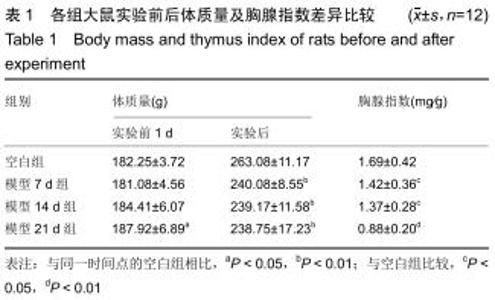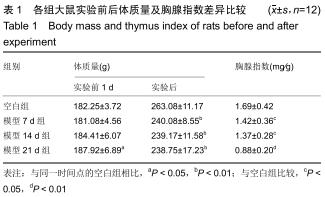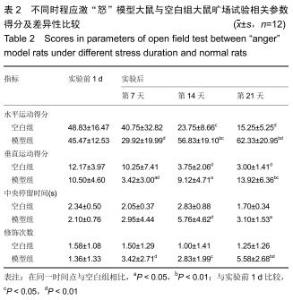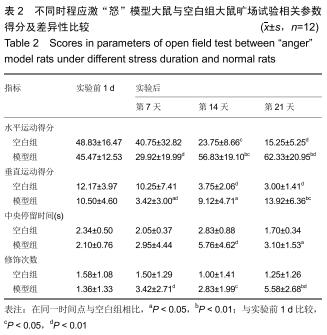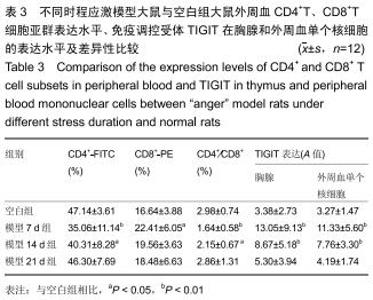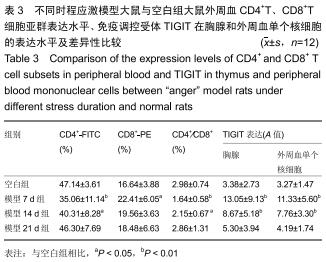|
[1] CHROUSOS GP. Stress and disorders of the stress system. Nat Rev Endocrinol.2009;5(7):374-381.
[2] ULRICH-LAI YM, HERMAN JP. Neural Regulation of Endocrine and Autonomic Stress Responses.Nat Rev Neurosci. 2009;10(6):397-409.
[3] DOOLEY J, LISTON A. Molecular control over thymic involution: From cytokines and microRNA to aging and adipose tissue.Eur J Immunol.2012;42(5):1073-1079.
[4] LEE JH, KIM TJ, KIM JW, et al. The Anti-apoptotic Effect of Ghrelin on Restraint Stress-Induced Thymus Atrophy in Mice. Immune Netw.2016;16(4):242-248.
[5] 黄文琴,周奇志,刘旭光,等.针刺对焦虑大鼠血浆及胸腺T细胞亚群的影响[J].针刺研究,2015,40(4):265-269.
[6] ABBAS AR, BALDWIN D, MA Y, et al. Immune response in silico (IRIS): immune-specific genes identified from a compendium of microarray expression data.Genes Immun. 2005;6(4):319-331.
[7] PAUKEN KE, WHERRY EJ. TIGIT and CD226: tipping the balance between costimulatory and coinhibitory molecules to augment the cancer immunotherapy toolkit.Cancer Cell.2014; 26(6):785-787.
[8] 何文涛,陈茜,余学锋.共抑制分子TIGIT的研究进展[J].现代免疫学,2014,34(5):436-438+372.
[9] 方亮,陈丽华,金伯泉.一种新的免疫抑制性受体TIGIT[J].细胞与分子免疫学杂志,2012,28(1):108-110.
[10] 李越峰,司昕蕾,等.四逆散对创伤后应激障碍及睡眠障碍大鼠海马区神经元放电波幅的影响研究[J].中国临床药理学杂志,2018, 34(10):1203-1205.
[11] WEI S, SUN P, ZHANG HY, et al. Impact of social isolation and resident intruder stress on aggressive behavior in the male rat. Neural Regen Res.2010;5(15): 1175-1179.
[12] SNYDER JS, SOUMIER A, BREWER M, et al. Adult hippocampal neurogenesis buffers stress responses and depressive behavior.Nature.2011;476(7361):458-461.
[13] 徐铭悦,倪红梅,何裕民,等.甘麦大枣汤对“怒”模型大鼠行为学特征的影响[J].中华中医药杂志,2017,32(6):410-413.
[14] GRUVER AL, SEMPOWSKI GD. Cytokines, leptin, and stress-induced thymic atrophy.J Leukoc Biol. 2008;84(4): 915-923.
[15] ZIVKOVIĆ IP, RAKIN AK, PETROVIĆ-DJERGOVIĆ DM, et al. Exposure to forced swim stress alters morphofunctional characteristics of the rat thymus.J Neuroimmunol. 2005; 160(1-2):77-86.
[16] DOMÍNGUEZ-GERPE L, REY-MÉNDEZ M. Alterations induced by chronic stress in lymphocyte subsets of blood and primary and secondary immune organs of mice.BMC Immunol. 2001;2:7.
[17] 关素珍,刘继文,连玉龙,等.慢性应激刺激致大鼠抑郁过程中红细胞免疫功能和T淋巴细胞亚群的变化[J].环境与职业医学,2010, 27(8):468-471.
[18] 王一赫,江虹,李颖,等.不同时程温和应激对大鼠海马神经元、T淋巴细胞亚群的动态影响[J].中国临床心理学杂志,2013,21(5): 731-734.
[19] ALMEIDA AR, BORGHANS JA, FREITAS AA. T Cell Homeostasis: Thymus Regeneration and Peripheral T Cell Restoration in Mice with a Reduced Fraction of Competent Precursors.J Exp Med. 2001 Sep 3;194(5):591-599.
[20] ALMEIDA AR, ROCHA B, FREITAS AA, et al. Homeostasis of T cell numbers: from thymus production to peripheral compartmentalization and the indexation of regulatory T cells. Semin Immunol. 2005;17(3):239-249.
[21] JARIWALA N, BENOIT B, KOSSENKOV AV, et al. TIGIT and Helios Are Highly Expressed on CD4+ T Cells in Sézary Syndrome Patients.J Invest Dermatol. 2017;137(1):257-260.
[22] JOLLER N, LOZANO E, BURKETT PR, et al. Treg Cells Expressing the Coinhibitory Molecule TIGIT Selectively Inhibit Proinflammatory Th1 and Th17 Cell Responses. Immunity. 2014;40(4):569-581.
[23] 刘婷婷,尹晓婉,张子宁,等.免疫调控受体PD-1和TIGIT在HIV感染者/HIV患者CD3~+CD4~-T细胞表达研究[J].现代免疫学, 2018,38(3):217-222.
[24] 尹晓婉,刘婷婷,张子宁,等. HIV感染者CD4~+T细胞TIGIT受体及其配体CD155表达情况研究[J].免疫学杂志,2017,33(11): 985-990.
[25] YU X, HARDEN K, GONZALEZ LC, et al. The surface protein TIGIT suppresses T cell activation by promoting the generation of mature immunoregulatory dendritic cells.Nature Immunology.2008; 10(1):48-57.
[26] GILLIET M, LIU YJ. Generation of Human CD8 T Regulatory Cells by CD40 Ligand-activated Plasmacytoid Dendritic Cells. J Exp Med.2002;195(6):695-704.
|
